For more than 30 years, the critic Camille Paglia has taught at the University of the Arts in Philadelphia. Now a faction of art-school censors wants her fired for sharing wrong opinions on matters of sex, gender identity, and sexual assault.
“Camille Paglia should be removed from UArts faculty and replaced by a queer person of color,” an online petition declares. “If, due to tenure, it is absolutely illegal to remove her, then the University must at least offer alternate sections of the classes she teaches, instead taught by professors who respect transgender students and survivors of sexual assault.” Regardless, the students behind the petition want her banned from holding speaking events or selling books on campus. In their telling, her ideas “are not merely ‘controversial,’ they are dangerous.”
Others believe that the student activists are trying to set a dangerous precedent that would undermine freedom of expression and free academic inquiry. “The effort to remove her for expressing her *opinions* strikes me as political correctness run amuck,” a faculty member emailed. “Instead of discussing and debating, they attempt to shame and destroy. This is pure tribalism. It is exactly what Donald Trump does when he encounters something he doesn’t like.” Most at the institution seem to hold positions somewhere in between.
[Read: A violent attack on free speech at Middlebury]
Camille Paglia, who identifies as transgender, joined the University of the Arts in 1984 when older institutions were merging in order to create it. While UArts no longer awards tenure, Paglia is among a few long-serving faculty members grandfathered into a prior system. According to detractors, “Paglia has been teaching at UArts for many years, and has only become more controversial over time.” In fact, she has always been controversial.
In Paglia’s first book, Sexual Personae: Art and Decadence From Nefertiti to Emily Dickinson, she describes sex and nature as “brutal, daemonic” forces, “criticizes feminists for sentimentality or wishful thinking about the causes of rape, violence, and poor relations between the sexes,” and roots sex differences in biology. Seven publishers rejected the book before Yale University Press bought it in 1990; Sexual Personae was then savaged by feminist critics on the way to becoming an unexpected, 700-page best seller. And it sparked a national debate about art, history, gender, ideas that offend, free inquiry, and political correctness.
The fight over Sexual Personae was especially vicious at Connecticut College, where a student suggested adding the book to the institution’s 1992 summer-reading list. Some professors were so outraged that they tried to block its inclusion.
“During meetings with the committee, professors denounced the work as ‘trash’ and compared it to Hitler’s ‘Mein Kampf,’” the Hartford Courant reported. In the campus newspaper, the head of the women’s-studies program opined, “Whenever we think about freedom of expression, we need to think also about the damage that certain kinds of speech can do. Let’s not be fooled by packaging into mistaking any hate-speech or sexist or racist doctrine for ideas.”
[Read: Camille Paglia doesn’t understand how civilizations commit suicide]
But Claire L. Gaudiani, the president of the college, countered, “It is a bizarre idea to think that by placing a book on a reading list that an academic community is endorsing any book as a community. For those who take offense at the various passages is understandable, but we cannot let that influence the book’s selection.”
Sexual Personae stayed on the list.
The student who originally proposed it commented at the time, “I got angry because I was seeing a great deal of intolerance that I would have sworn a few months ago did not exist at Connecticut College. I fear a little bit for the future of the reading program with people here who might try to stifle the diversity of ideas.”
As incoming freshmen arrived for the fall semester, the controversy was still simmering, according to an account published in August 1992 in The New York Times:
Students interviewed on campus said they were more motivated to read the book because the controversy has provoked so much discussion. “When someone tells you not to read something, I suppose that makes you all the more curious to see what all the fuss is about,” said one incoming freshman woman. “I agreed with some things in the book and disagree with others, but I certainly think I am capable of understanding it and discussing its meaning. It’s pretty condescending for a professor to think that freshmen aren’t capable of that …”
The president of the student government, Colleen Shanley, added: “Now that I’ve started reading the book, I can’t see why people have been opposed to it. But I feel that it’s when people don’t talk about something that it can become really dangerous. I may not agree with the book’s content, but we should not be removing books from reading lists because don’t agree with them.”
In The Washington Post, the columnist Nat Hentoff argued that “the students in particular saved the book––and the intellectual credibility––of Connecticut College,” endorsing the question posed by one among them: “What is more dangerous––to talk about ideas in the open, or to pretend they do not exist? If we cannot discuss controversial ideas here, where can we have open-minded debate?”
Paglia has been outspoken ever since, transgressing against conservative and progressive pieties alike while commenting on matters of art, culture, politics, and identity. Now it is a group of students, rather than professors, who believe it is more dangerous to talk openly about her ideas than to ban them from campus.
[Read: Who’s afraid of free speech?]
Any student, regardless of ideology or personal identity, risks discomfort attending a Paglia lecture, given the pedagogical approach she has described:
The idea that ‘self-esteem’ should be the purpose of education: this is social-welfare propaganda. Development of our intellect and of our abilities has to be the focus … You build identity. Maybe identity comes through conflict. For example, my struggles with gender, my struggles with sexual orientation, my anguish over so many decades produced my work … Sometimes conflict is creative …
If there’s no pressure on you, there’s no pressure to create.
So we have got to stop this idea that we must make life “easy” for people in school … No. Maybe the world is harsh and cruel, and maybe the world of intellect is challenging and confrontational and uncomfortable. Maybe we have to deal with people who hate us, directly, face-to-face. That’s important. You develop your sense of identity by dealing with the things which would obliterate your identity. It does not help you to develop your identity by putting a cushion between yourself and the hateful reality that’s out there.
This month’s protests began when it was announced that Paglia would give a lecture titled “Ambiguous Images: Sexual Duality and Sexual Multiplicity in Western Art.” According to a letter that two student activists released, “Joseph McAndrew (they/them), a gender non-binary creative writing major, brought this lecture to the student body’s attention through social media and raised their concerns to Title IX and other University administration about the school giving Camille a platform. This led to the University reaching out to Deja Lynn Alvarez, a local transgender activist, to facilitate a talk-back after Camille’s lecture. Students were informed the day before the lecture that Camille had no plans to stay for the talk-back.”
It is rare for student activists to argue that a tenured faculty member at their own institution should be denied a platform. Otherwise, the protest tactics on display at UArts fit with standard practice: Activists begin with social-media callouts; they urge authority figures to impose outcomes that they favor, without regard for overall student opinion; they try to marshal antidiscrimination law to limit freedom of expression. David Bernstein described this process in his 2004 book, You Can’t Say That.
To help justify the effort to suppress Paglia’s speech, student activists pointed to an interview posted to YouTube in which she dismissed some allegations of campus sexual assault:
The girls have been coached now to imagine that the world is a dangerous place, but not one that they can control on their own … They expect the omnipresence of authority figures … They’re college students and they expect that a mistake that they might make at a fraternity party and that they may regret six months later or a year later, that somehow this isn’t ridiculous? To me, it is ridiculous that any university ever tolerated a complaint of a girl coming in six months or a year after an event. If a real rape was committed go frigging report it …
A student cited those remarks in an email explaining why she supports the anti-Paglia protests: “As a survivor of sexual assault, I would never feel comfortable taking a class with someone who stated that ‘It’s ridiculous … that any university ever tolerated a complaint of a girl coming in six months or a year after an event,’ or that ‘If a real rape was committed, go friggin’ report it to police.’ Perhaps this is an ‘opinion,’ but it’s a dangerous one, one that propagates rape culture and victim-blaming. For this and other reasons, I find her place as an educator at this university extremely concerning and problematic.”
[Adam Serwer: A nation of snowflakes]
Even if students who feel that way should be able to avoid Paglia’s classes, they should not try to impose their preferences on their peers.
UArts administrators felt similarly, declining to cancel the public lecture that Paglia was scheduled to deliver. The student activists responded by protesting the event. In an open letter, the student Sheridan Merrick described what happened next:
We sat out of the way of the door, simply holding signs and chatting amongst ourselves. When the doors to the event were opened, students had the option of attending the lecture (during which no protest signs would be allowed into the space), or remaining in the lobby. Most students chose to peacefully observe the lecture. As students entered … security guards carefully counted the number of audience members and immediately cut students off at the maximum capacity (180 people), no standing room allowed. All other entrances to the recital hall were locked and blocked by security guards.
Around 30 to 40 minutes into Camille’s talk, the fire alarm went off (rumor has it due to it being pulled by a student in protest, though I have no way of confirming this), and Terra building was evacuated. Students who were in class or rehearsal joined those who had been protesting outside of Terra building, chanting: “We believe survivors, trans lives matter.” There were probably around two hundred students chanting this, but I can’t be sure. I only observed one or two students (cisgender “allies”) become even remotely aggressive in their behavior, and by this I mean shouting curse words.
Two UArts educators who were present described how they experienced the same event in emails to me. One wanted to voice “the frustrations of some of the students in attendance, a number of them trans and queer identifying, who under unthinkable pressures from their peer group to conform to the political agenda du jour, showed up that night not to protest but to listen, presumably out of a belief that the ideas that challenge them are often the ideas most likely to nourish them.” While they might “deplore much of what she has said about trans identity and rape culture,” the educator continued, “they also didn’t assume that Camille’s scholarship was therefore invalid or dangerous or traumatizing. It’s the studiousness, integrity, and (yes) courage like theirs that often goes unremarked upon in coverage of these campus eruptions.”
The other educator pointed out that the person who pulled the fire alarm interfered not only with the educational opportunities of students who chose to attend Paglia’s public lecture, but also everyone else taking classes in the building. This educator noted how much money students spend to attend classes:
I take it, and them, very seriously. In one class the students were to finish projects that they had been working on for weeks, with focused assistance. The fire alarm took them out of class for over an hour while they stood outside to listen to a group screaming “trans lives matter!” at them. What did this produce? Projects weren’t finished, the class wasn’t finished, the students lost out. I don’t care if they were black, trans AND disabled—I was there to help them learn 100 percent. And I was blocked from doing that, that night.
A third educator spoke with students and relayed their perspective. “My students seemed to feel as though they were crossing something of a picket line just to be attending the event without the intent of shouting Camille down,” he emailed. “That an opinion differing from the majority’s, even at a place of supposed open mindedness and tolerance, can so readily be codified as ‘harmful’ and/or ‘violent’ is deeply concerning to me. And that Camille holds her own, perhaps unique, opinions should not automatically make her a threat.”
As significant as the protest itself was the response by UArts President David Yager, who released a long statement defending free expression. Its core message:
Across our nation it is all too common that opinions expressed that differ from one another’s––especially those that are controversial––can spark passion and even outrage, often resulting in calls to suppress that speech. That simply cannot be allowed to happen. I firmly believe that limiting the range of voices in society erodes our democracy. Universities, moreover, are at the heart of the revolutionary notion of free expression: promoting the free exchange of ideas is part of the core reason for their existence. That open interchange of opinions and beliefs includes all members of the UArts community: faculty, students and staff, in and out of the classroom. We are dedicated to fostering a climate conducive to respectful intellectual debate that empowers and equips our students to meet the challenges they will face in their futures.
I believe this resolve holds even greater importance at an art school. Artists over the centuries have suffered censorship, and even persecution, for the expression of their beliefs through their work. My answer is simple: not now, not at UArts.
Later, when student activists launched their online petition, they included the demand, “Yager must apologize for his wildly ignorant and hypocritical letter.”
In a phone interview, Yager told me that he admires the impulse of today’s students to involve themselves in social-justice causes that are greater than themselves, that freedom of expression is especially sacrosanct at an art college, and that he is attentive to the fact that any impingement on Paglia’s ideas, regardless of the merits of those ideas, would have a chilling effect on all speech.
“I would hate to neuter all faculty,” he said.
Yager’s concerns seem warranted. While reporting on this story, I emailed scores of UArts faculty members to solicit comment. A few were willing to speak on the record. Many more on both sides of the controversy insisted that their comments be kept off the record or anonymous. They feared openly participating in a debate about a major event at their institution––even after their university president put out an uncompromising statement in support of free speech––though none expressed any view that couldn’t be broadcast on NPR.
[Read: The coddling of the American mind]
“I’m a faculty member at UArts,” one wrote. “I received your email and thought it prudent to respond using my personal email address. I very much doubt that the IT dept is currently monitoring email activity. BUT they have the ability AND certainly can look up records without privacy concerns. So this is a bit safer. Especially since if I do speak with you it’d be paramount that I be OFF the record. The university has social media/email policies for their faculty.”
Another educator at the college emailed:
In his response, Pres. Yager notes that universities are “at the heart of the revolutionary notion of free expression,” but it is tenure that is supposed to protect academics and give them this freedom he mentions. The vast majority of UArts’ faculty are adjunct or un-tenured full- and part-time instructors who don’t have the same privileges and platform as Dr. Paglia, which makes the whole scenario unbalanced. UArts’ compensation for adjuncts is below average and adjuncts here are not eligible for healthcare or benefits. Within the liberal arts area, Dr. Paglia may be the only tenured faculty member. I think the ethical and appropriate response to this situation is for UArts to commit to hiring more full-time and tenured faculty.
A third educator wrote, “Please do not include my name in your article. Things are rather tense at UArts and we are living in cancel culture, after all. I am in close emotional proximity to students who have signed and promoted the petition. I am not willing to share my thoughts publicly but will consent to share anonymously.” The view this educator feared sharing:
I do not believe she should be removed as a faculty member but I also believe the school belongs to the students. They do not feel safe and I applaud them for taking action to change their environment. I cannot support their cause, however. I believe Paglia represents intellectual dissent within an institution (academia, at large) that often seeks to maintain the status quo and mediocrity of vision. Her perspective, as historically informed and contextualized, is far more objective than students with a limited and subjective scope of understanding at this point in their lives can intellectually grapple with. I think that if they truly listened, they might hear her voice more clearly as someone who seeks to empower the individual above all else.
“Ultimately,” the faculty member concluded, “it is their loss.”
Something has gone wrong in academia when so many faculty members are unwilling to express common viewpoints under their own names.
To better understand the student-activist perspective, I emailed Sheridan Merrick, who posted the Change.org petition. Paglia has been teaching for at least 35 years, I pointed out. If her ideas are not merely controversial but “dangerous,” that implies they have harmed students. Is that the case?
In reply, Merrick cited statistics about the percentage of transgender adults who report having attempted suicide or suffered hate crimes. From there she reasoned:
Paglia’s comments have echoed the hateful language that pushes so many transgender people to contemplate suicide, and encourage transphobic people to react to transgender people violently. We have been experiencing an interesting phenomenon where Paglia’s supporters have been signing our petition in order to leave dissenting comments (this is especially odd considering they have a counter petition that they are welcome to sign). Some of these comments are extremely concerning and blatantly transphobic.
Just one example: “You are either born male, female, or deformed (physically or mentally). Trans people are mentally diseased and often violent. If they are not able to accept the reality of their disease and cope with it they must be removed from society by any means necessary. Some might argue that the high suicide rate among those suffering from this severe mental disease is nature correcting itself. Camille Paglia is a transgender person who was able to accept and overcome her mental disease. Be like Camille.”
Like it or not, Paglia’s philosophies empower people like this, who would have transgender people “removed from society by any means necessary” (this is a violent threat). This has a lasting, negative impact on the transgender community at UArts––whether it be through the psychological damage that comes with being told that you are deformed and diseased and deserve to die, or whether it be through people like Paglia’s supporters acting on their violent beliefs. To have her spouting these beliefs in the classroom and elsewhere makes life more difficult––and dangerous––for transgender students.
I personally know at least one person who, due to Paglia’s comments, has experienced suicidal thoughts and has considered leaving the University. The comments that many of us have been receiving online have caused public safety at our school to be told to up their security game, in case our (very queer) student body is targeted by angry supporters of hers. This is what we mean when we say that her views are not merely controversial, but dangerous.
That argument—a speaker is responsible for harms that are theoretical, indirect, and so diffuse as to encompass actions of strangers who put themselves on the same side of a controversy —is untenable. Suppressing speech because it might indirectly cause danger depending on how people other than the speaker may react is an authoritarian move. And this approach to speech, applied consistently, would of course impede the actions of the anti-Paglia protesters as well.
After all, Paglia identifies as transgender, making her a member of the group at heightened risk of suicide. She was subjected to angry chants from perhaps 200 students, including two cisgender students who shouted curse words at her, not to mention an ongoing effort to take away her livelihood and force her from her longtime community. Social-media protests and the Change.org petition led to vitriol and threats, as in any major culture-war controversy. So treated, many people would suffer more psychological distress than if they saw a YouTube clip, however odious, that didn’t target them personally.
What’s more, when student activists strategically engage in protests, callouts, and other behavior expressly calculated to “make life more difficult” for others, they could indirectly inspire outside parties to engage in threats or even attacks.
Merrick also offered a more bureaucratic line of argument:
The faculty handbook states the following:
“Gender-based harassment is defined as any unwelcome verbal or non-verbal contact or conduct based upon sex or gender, sexual orientation, gender identity or gender expression. Gender-based harassment need not be sexual in nature to be specifically prohibited by this policy. Gender-based harassment includes, but is not limited to, the following: physical assault or physical interference intended to harass on the basis of gender; inappropriate graphics or other displays of gender degrading materials; sexist jokes, anecdotes, or slurs; and insulting, demeaning or derogatory conduct direct toward a person on the basis of their gender. This policy applies to conduct that occurs:
(1) On University premises or property; and/or
(2) In the context of University employment, education, research, recreational, social or artistic activity, irrespective of the location of the occurrence, if the conduct has or can be reasonably predicted to have a continuing negative effect on the University and its students, faculty, visiting faculty, affiliates, staff, contractors, vendors, visitors or guests.”
It seems to me that referring to transgender students as “sniveling little maniacs” is insulting, demeaning, and derogatory towards people on the basis of gender.
The “sniveling little maniacs” quote comes from an event where Paglia was asked about efforts to oust Jordan Peterson from the University of Toronto, after Peterson said professors should not have to use their students’ preferred pronouns. In context, it is clear that “sniveling little maniacs,” whether objectionable or not, refers to activists who believe they are justified in forcing their pronoun choices on others, not transgender students generally. Here is the clip:
Once again, the student activists wield a double-edged sword. If Paglia’s comments qualify as “insulting, demeaning, and derogatory towards people on the basis of gender,” so does lots of speech that is very common on the academic left. For example, locutions such as mansplaining, man-spreading, white male rage, male privilege, toxic masculinity, male gaze, manterrupting, and bropropriating would all be subject to challenge under similarly broad readings of the very same passages in the faculty handbook.
In contrast, robust speech protections like the ones that permitted the Paglia lecture would enable UArts to host events with speakers like the feminist scholar Suzanna Danuta Walters. “Is it really so illogical to hate men?” she asked in a provocative op-ed in The Washington Post. “For all the power of #MeToo and #TimesUp and the women’s marches, only a relatively few men have been called to task … But we’re not supposed to hate them because … #NotAllMen … when they have gone low for all of human history, maybe it’s time for us to go all Thelma and Louise and Foxy Brown on their collective butts.”
Would progressive student activists at UArts favor the expansive interpretation of antidiscrimination language that they are urging if they understood that it would likely result in the suppression of many voices on the identitarian left? Perhaps they anticipate a different outcome: UArts could employ a double standard, allowing academics to freely criticize members of some identity groups but not others, because men are historically privileged while women, gay people, and people of other gender identities are historically marginalized.
But adopting different standards for different identity groups—which would of course never fly in a legal context—would ultimately hurt historically marginalized groups.
Paglia possesses all sorts of knowledge that any student could benefit from understanding. (Understanding doesn’t imply agreeing.) The identitarian conceit is that trans people and survivors of sexual assault can’t learn from Paglia, because she renders them “unsafe.” Meanwhile, cis white males are acculturated to believe that they can always learn from anyone, even professors overtly hostile to their race, sexual orientation, or gender identity. In this way, left-identitarianism encourages historically marginalized groups to believe that they are less resilient and less capable than their white, male classmates. They suggest, falsely, that “harm” is the only possible result of listening to controversial (or even offensive) ideas.
There are, finally, political costs of illiberal activism. By targeting Paglia’s job, student activists may alienate people who are open to substantive critiques of her ideas, yet insistent on the absolute necessity of safeguarding a culture of free speech, regardless of whether the speech in question is “correct” or “incorrect.” They fail to heed Henry Louis Gates’s prescient warning not to divide the liberal civil-rights and civil-liberties communities.
The activists also fail to heed a much older lesson that art students ought to know best: Nothing makes an act of free expression more intriguing than an attempt to censor it.
This article originally misstated when Camille Paglia was hired by one year.

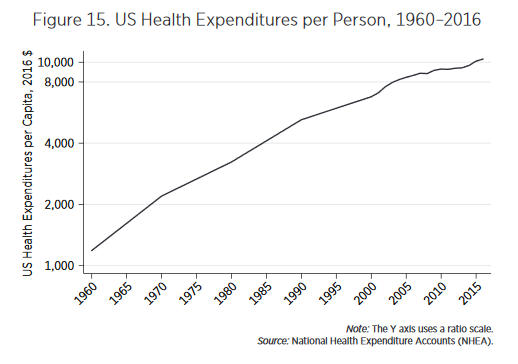 Second, explanations of rising prices that focus on bad things such as monopoly power or rent seeking tend to imply that price increases should be largest when the economy is doing poorly. In contrast, the Baumol effect predicts that increases in relative prices will be largest when the economy is booming. Consider health care. From news reports you might think that health care costs have gotten more “out of control” over time. In fact, the fastest increases in health care costs were in the 1960s. The graph at left is on a ratio scale so slopes indicate rates of growth and what one sees is that the growth rate of health expenditures per person is slowing. That might seem good but remember, from the Baumol point of view, the decline in relative price growth reflects slowing growth elsewhere in the economy.
Second, explanations of rising prices that focus on bad things such as monopoly power or rent seeking tend to imply that price increases should be largest when the economy is doing poorly. In contrast, the Baumol effect predicts that increases in relative prices will be largest when the economy is booming. Consider health care. From news reports you might think that health care costs have gotten more “out of control” over time. In fact, the fastest increases in health care costs were in the 1960s. The graph at left is on a ratio scale so slopes indicate rates of growth and what one sees is that the growth rate of health expenditures per person is slowing. That might seem good but remember, from the Baumol point of view, the decline in relative price growth reflects slowing growth elsewhere in the economy.

 The bloat theory is superficially plausible. The
The bloat theory is superficially plausible. The 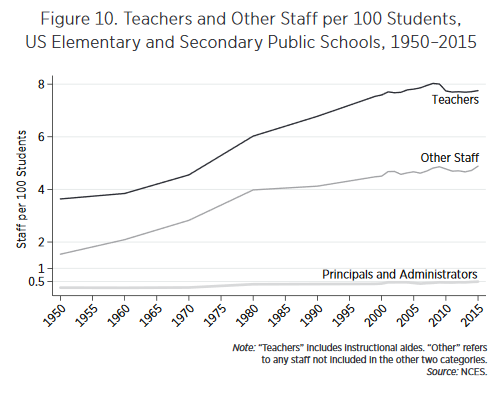 Nor is it true that administrators are taking over the public schools, see Figure 10.
Nor is it true that administrators are taking over the public schools, see Figure 10.




















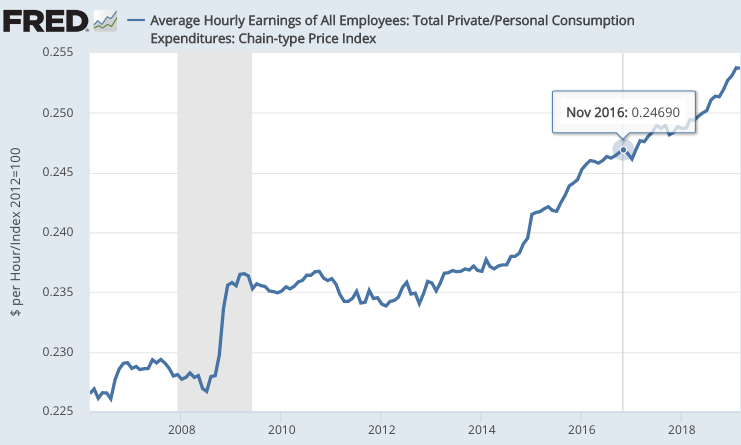 BTW, in nominal terms, average hourly earnings are currently $27.77/hour.
BTW, in nominal terms, average hourly earnings are currently $27.77/hour. I could not find median hourly wages, but they did have data on median weekly wages (currently $905):
I could not find median hourly wages, but they did have data on median weekly wages (currently $905):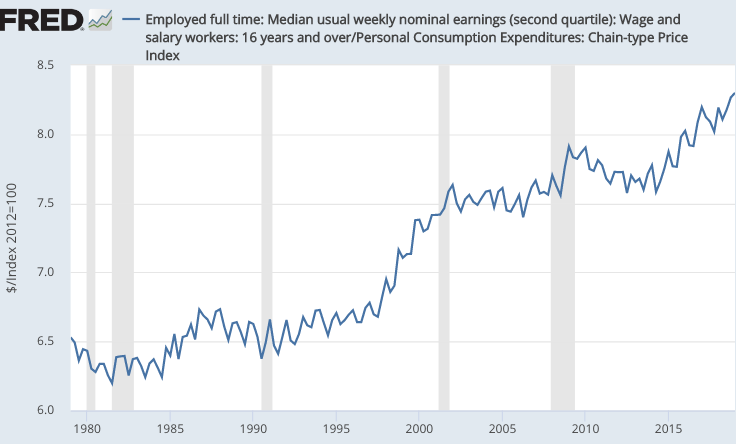 There was a period of stagnant real wages, but it ended in the mid-1990s. All of these series show significant growth in real wages since the mid-1990s. Whatever explains the rise of populism in America, it is not stagnant wages.
There was a period of stagnant real wages, but it ended in the mid-1990s. All of these series show significant growth in real wages since the mid-1990s. Whatever explains the rise of populism in America, it is not stagnant wages.
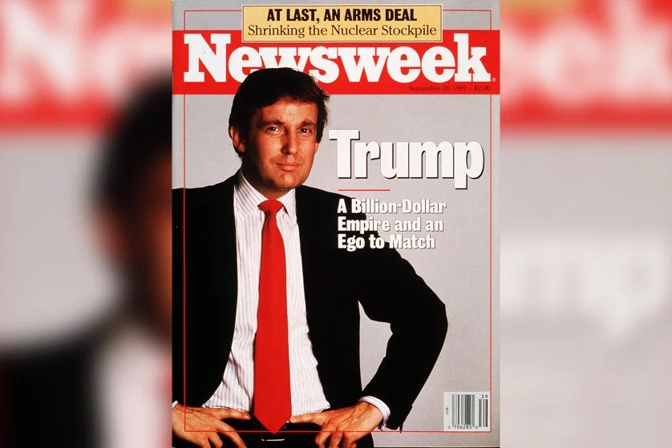


/cdn.vox-cdn.com/uploads/chorus_asset/file/16221071/farm5.jpg) Neon
Neon
/cdn.vox-cdn.com/uploads/chorus_asset/file/16221075/farm4.jpg) Neon
Neon
/cdn.vox-cdn.com/uploads/chorus_asset/file/16221077/farm3.jpeg) Neon
Neon
/cdn.vox-cdn.com/uploads/chorus_asset/file/16221079/farm2.jpg) Neon
Neon

/cdn.vox-cdn.com/uploads/chorus_asset/file/16127441/Screen_Shot_2019_04_17_at_10.34.27_AM.png)
 St. Jude
St. Jude






